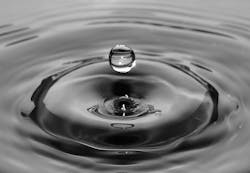Updated 8/24/21
Of all the buzzwords that are swimming around the world of water quality these days total dissolved solids in water, “TDS”, is one of the most common. Industry professionals range from being fully versed in the subject to being marginally aware, while the average consumer would most likely guess it is an abbreviation for touchdowns. Given that total dissolved solids is by far the most common parameter for water quality testing, an overview of the subject is warranted.
What Does TDS Mean?
According to Wikipedia, total dissolved solids (TDS) is defined as “the combined content of all inorganic and organic substances contained in a liquid that are present in a molecular, ionized or microgranular suspended form.” The article goes on to state that “total dissolved solids are differentiated from total suspended solids (TSS) in that the latter cannot pass through a sieve of two micrometers but are indefinitely suspended in solution.”
In other words, TDS is anything—other than the pure H2O—in water that you cannot see. This could include any salt, metal or mineral, and the lower the TDS level is, the purer the water.
RELATED: Water Testing
So then why should total dissolved solids be measured? As an overall indicator of water purity, total dissolved solids is an especially important parameter, and more often than not, it is the first one tested. A total dissolved solids test is quick, easy and inexpensive. A single total dissolved solids meter can be used thousands of times, requiring nothing more than the occasional recalibration and new batteries.
Water filtration, treatment and purification often become a question of cost-effectiveness. Knowing the TDS level will help determine what, if any, type of system or process is required. Along these lines, a TDS meter is an excellent tool for determining the efficacy of many types of water filtration and purification systems.
Many people still rely on the old-fashioned methods of time or flow to determine when the filter cartridge or membrane needs to be changed. Because usage may vary and the TDS levels of water supplies fluctuate, time and flow are far from precise methods. With improved technology in TDS measurement being coupled with accessible prices, the focus is definitely moving away from a reliance on time and flow.
How Is Total Dissolved Solids (TDS) Measured?
TDS is measured on a quantity scale, either in mg/L or, more commonly, in parts per million (ppm). Simply put, if the TDS level is 335 ppm, this means that out of one-million parts of H2O, 335 of those parts are something else.
The only true method of measuring TDS is to evaporate a water sample and weigh the remains with a precision analytical balance. While this is the most reliable and accurate method, it is also costly. Because a precision analytical balance that can evaporate water is not on the top of the average water industry professional’s shopping list, there are alternatives. Over the past few decades, companies have developed TDS meters—inexpensive tools to help measure TDS in water.
What is a TDS Meter?
Ironically, a TDS meter does not initially measure TDS, which is where much of the confusion arises. TDS meters, also known as TDS testers or indicators, are digital or analog meters that measure the electrical conductivity of water. Based on that conductivity, the meters estimate what the true TDS level might be.
As stated previously, TDS is essentially anything dissolved in the water other than the pure H2O. Because hydrogen and oxygen conduct virtually no electricity, and most other elements do, the conductivity measurement is a fair indicator of the overall water purity.
In reality, a TDS meter measures the electrical conductivity of water or, in other words, the total amount of mobile charged ions found in water. If an element is dissolved in water and can conduct electricity, it is called an electrolyte. Salt, for example, is an electrolyte. Sugar, however, is not and will therefore not register on a conductivity or TDS meter. This is one reason why a TDS meter is only an estimate of the true TDS.
Additionally, different types of water will contain different quantities of certain dissolved substances. For example, seawater will naturally have far more salt than freshwater. To accommodate this difference, TDS meters will incorporate conversion factors, typically ranging from 0.4 to 1, to convert the conductivity to the estimated TDS level. As a general rule of thumb, the higher the conductivity, the higher the conversion factor.
Although the measurement on a TDS meter is an estimate, it is reasonably accurate. When simplicity, accessibility and cost are taken into account compared with a precision analytical balance, a TDS meter is more than sufficient for most applications.
A common question that arises is: “At what TDS level should tap water be?” There is no right or wrong answer to this question because the TDS levels of tap water fluctuate widely from location to location and from day to day. Pipe age can affect TDS levels, as can precipitation (or lack thereof).
Neither the U.S. federal government nor any of the states set minimum TDS levels on water; however, maximum levels are set. Some of these levels are enforceable, while others are only recommendations. The U.S. Environmental Protection Agency includes TDS on its list of National Secondary Drinking Water Regulations (NSDWR) and sets a limit of 500 mg/L; however, the NSDWRs are nonenforceable guidelines.
What Else Does Total Dissolved Solids (TDS) Affect?
Besides drinking water, TDS affects anything that consumes, lives in or uses water. For example, high levels of TDS will result in excessive scaling in pipes. On the other hand, low levels of TDS may be unhealthy for plants and fish.
The measurement of TDS in water is also extremely important for certain pharmaceutical, manufacturing, industrial, medical and agricultural applications, to name a few.
With a number of economically priced, accurate and easy-to-use TDS meters available on the market, there is no reason not to use one.
Download: Here



